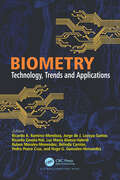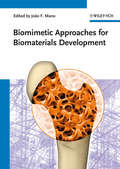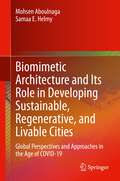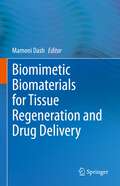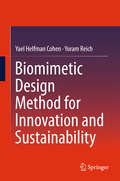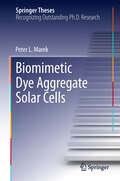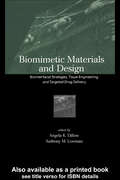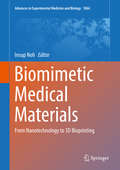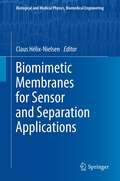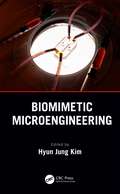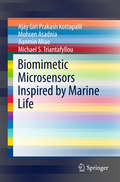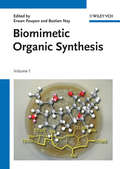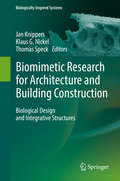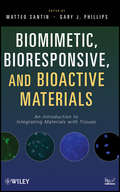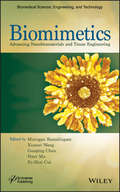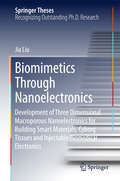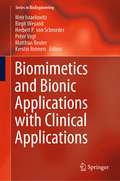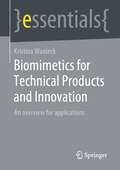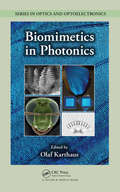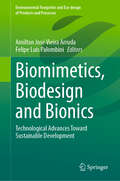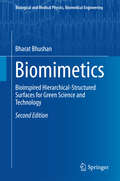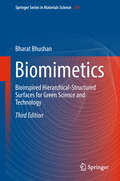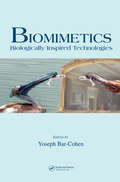- Table View
- List View
Biometry: Technology, Trends and Applications
by Ricardo A. Ramirez-Mendoza, Jorge de J. Lozoya-Santos, Ricardo Zavala-Yoé, Luz María Alonso-Valerdi, Ruben Morales-Menendez, Belinda Carrión, Pedro Ponce Cruz and Hugo G. Gonzalez-HernandezBiometrics provide quantitative representations of human features, physiological and behavioral. This book is a compilation of biometric technologies developed by various research groups in Tecnologico de Monterrey, Mexico. It provides a summary of biometric systems as a whole, explaining the principles behind physiological and behavioral biometrics and exploring different types of commercial and experimental technologies and current and future applications in the fields of security, military, criminology, healthcare education, business, and marketing. Examples of biometric systems using brain signals or electroencephalography (EEG) are given. Mobile and home EEG use in children’s natural environments is covered. At the same time, some examples focus on the relevance of such technology in monitoring epileptic encephalopathies in children. Using reliable physiological signal acquisition techniques, functional Human Machine Interfaces (HMI) and Brain-Computer Interfaces (BCI) become possible. This is the case of an HMI used for assistive navigation systems, controlled via voice commands, head, and eye movements. A detailed description of the BCI framework is presented, and applications of user-centered BCIs, oriented towards rehabilitation, human performance, and treatment monitoring are explored. Massive data acquisition also plays an essential role in the evolution of biometric systems. Machine learning, deep learning, and Artificial Intelligence (AI) are crucial allies here. They allow the construction of models that can aid in early diagnosis, seizure detection, and data-centered medical decisions. Such techniques will eventually lead to a more concise understanding of humans.
Biomimetic Approaches for Biomaterials Development
by Joao F. ManoBiomimetics, in general terms, aims at understanding biological principles and applying them for the development of man-made toolsand technologies. This approach is particularly important for the purposeful design of passive as well as functional biomaterials that mimicphysicochemical, mechanical and biological properties of natural materials, making them suitable, for example, for biomedical devices oras scaffolds for tissue regeneration.The book comprehensively covers biomimetic approaches to the development of biomaterials, including: an overview of naturally occurringor nature inspired biomaterials; an in-depth treatment of the surface aspects pivotal for the functionality; synthesis and self-assemblymethods to prepare devices to be used in mineralized tissues such as bone and teeth; and preparation of biomaterials for the controlled/sustained release of bioactive agents. The last part reviews the applications of bioinspired materials and principles of design in regenerativemedicine such as in-situ grown bone or cartilage as well as the biomimetic techniques for soft tissue engineering.The comprehensive scope of this book makes it a must-have addition to the bookshelf of everyone in the fields of Materials Science/Engineering, Nanotechnologies / Nanosciences, Medical Sciences, Biochemistry, Polymer Chemistry, and Biomedical Engineering.
Biomimetic Architecture and Its Role in Developing Sustainable, Regenerative, and Livable Cities: Global Perspectives and Approaches in the Age of COVID-19
by Mohsen Aboulnaga Samaa E. HelmyThis book focuses on understanding biomimetic architecture and its role as a sustainable design tool. It presents the role of biomimicry in mitigation and adaptation to climate change and examines how biomimetic architecture can provide healthy solutions to limit the spread of COVID-19 in buildings and cities. Coverage includes global examples of biomimetic approaches and buildings, an evaluation of the performance of biomimicry applications in architecture to illustrate best practices, and an exploration of how nature can offer inspiration in building design to conserve resources and save energy use as well as curb carbon emissions – a reaffirmed goal of COP 26 and an outcome of Glasgow Climate Pact. Finally, the book presents guidelines to enhance urban areas and healthier spaces in buildings to meet COVID-19 social distance regulations and beyond.Examines global applications of biomimicry in architecture;Highlights the importance of biomimicry in driving livability in cities and buildings;Explores the role of biomimetic architecture in mitigating climate change.“The line of argument developed is highly relevant to the present, in addition to being original and pertinent to research on urban regeneration, especially in regard to the exploration of the use of biomimicry architecture in response to changing urban demands.” —Alessandra Battisti, Ph.D., Professor of Architecture, University of Rome La Sapienza-
Biomimetic Biomaterials for Tissue Regeneration and Drug Delivery
by Mamoni DashThis book illustrates the influence of biomimetics in the field of tissue engineering and drug delivery. These two distinct fields of regenerative medicine have greatly benefited from the concept of biomimetics, which focuses on using or imitating nature to develop materials for improving human lives. The book begins by highlighting the relevance and recent advances in biomimetic biomaterials. An updated and innovative content has been presented in terms of biomimetic systems that are being utilized in controlled delivery and stem cell therapy. Further, the book reviews the role of these materials in enhanced capacity for drug loading, cellular uptake, and controlled release within the target cells. The book includes advanced techniques for characterizing biomimetic biomaterials and highlights their pivotal role in providing three-dimensional templates and synthetic extracellular matrices.
Biomimetic Design Method for Innovation and Sustainability
by Yoram Reich Yael Helfman CohenPresenting a novel biomimetic design method for transferring design solutions from nature to technology, this book focuses on structure-function patterns in nature and advanced modeling tools derived from TRIZ, the theory of inventive problem-solving. The book includes an extensive literature review on biomimicry as an engine of both innovation and sustainability, and discusses in detail the biomimetic design process, current biomimetic design methods and tools. The structural biomimetic design method for innovation and sustainability put forward in this text encompasses (1) the research method and rationale used to develop and validate this new design method; (2) the suggested design algorithm and tools including the Find structure database, structure-function patterns and ideality patterns; and (3) analyses of four case studies describing how to use the proposed method. This book offers an essential resource for designers who wish to use nature as a source of inspiration and knowledge, innovators and sustainability experts, and scientists and researchers, amongst others.
Biomimetic Dye Aggregate Solar Cells (Springer Theses)
by Peter L. MarekThis thesis describes a new approach to the construction of solar cells. Following nature's example, this approach has the goal to find a biomimetic self-assembling dye, whose aggregates can mimic the natural light-harvesting system of special photosynthetic active bacteria. The thesis investigates methods to control the self-assembly such that suitable dye aggregates are formed with high internal order and size-confinement. The dye aggregates can be implemented into a new type of solar cells, designed to combine the advantages of hybrid solar cells and solid-state dye-sensitized solar cells (ss-DSSCs): dye aggregate solar cells (DASCs). This book describes the construction and first tests of a prototype for DASCs on the basis of the investigated dye aggregates. The described approach has the advantage that it will enable to build up a light-harvesting system fully synthetically in large scale in order to realize low-cost, light-weight and environmentally friendly solar cells - a worthwhile goal towards the exploitation of clean energy from sunlight.
Biomimetic Materials And Design: Biointerfacial Strategies, Tissue Engineering And Targeted Drug Delivery
by Angela K. Dillow Anthony M. LowmanDetailing techniques in wound healing and reconstruction, this reference describes the mechanisms and architecture of biological systems to formulate and design natural and synthetic compounds, degradable and non-degradable scaffolds, and targeted drug delivery devices. It offers strategies to control adhesive interactions, elicit specific cellular responses, and improve the biocompatibility, performance, and durability of prosthetic materials. Covering advances in the field, the book discusses the effect of topographical features on cell behaviors such as orientation, adhesion, migration, proliferation, and differentation.
Biomimetic Medical Materials: From Nanotechnology to 3D Bioprinting (Advances in Experimental Medicine and Biology #1064)
by Insup NohThis volume outlines the current status in the field of biomimetic medical materials and illustrates research into their applications in tissue engineering. The book is divided into six parts, focusing on nano biomaterials, stem cells, tissue engineering, 3D printing, immune responses and intellectual property. Each chapter has its own introduction and outlines current research trends in a variety of applications of biomimetic medical materials. The biomimetic medical materials that are covered include functional hydrogels, nanoparticles for drug delivery and medicine, the 3D bioprinting of biomaterials, sensor materials, stem cell interactions with biomaterials, immune responses to biomaterials, biodegradable hard scaffolds for tissue engineering, as well as other important topics, like intellectual property. Each chapter is written by a team of experts. This volume attempts to introduce the biomimetic properties of biomedical materials within the context of our current understanding of the nanotechnology of nanoparticles and fibres and the macroscopic aspects of 3D bioprinting.
Biomimetic Membranes for Sensor and Separation Applications (Biological and Medical Physics, Biomedical Engineering)
by Claus Hélix-NielsenThis book addresses the possibilities and challenges in mimicking biological membranes and creating membrane-based sensor and separation devices. Recent advances in developing biomimetic membranes for technological applications will be presented with focus on the use of integral membrane protein mediated transport for sensing and separation. It describes the fundamentals of biosensing as well as separation and shows how the two processes are working in a cooperative manner in biological systems. Biomimetics is a truly cross-disciplinary approach and this is exemplified using the process of forward osmosis will be presented as an illustration of how advances in membrane technology may be directly stimulated by an increased understanding of biological membrane transport. In the development of a biomimetic sensor/separation technology, both channels (ion and water channels) and carriers (transporters) are important. An ideal sensor/separation device requires the supporting biomimetic matrix to be virtually impermeable to anything but the solute in question. In practice, however, a biomimetic support matrix will generally have finite permeabilities to water, electrolytes, and non-electrolytes. These non-protein mediated membrane transport contributions will be presented and the implications for biomimetic device construction will be discussed. New developments in our understanding of the reciprocal coupling between the material properties of the biomimetic matrix and the embedded proteins will be presented and strategies for inducing biomimetic matrix stability will be discussed. Once reconstituted in its final host biomimetic matrix the protein stability also needs to be maintained and controlled. Beta-barrel proteins exemplified by the E. Coli outer membrane channels or small peptides are inherently more stable than alpha-helical bundle proteins which may require additional stabilizing modifications. The challenges associated with insertion and stabilization of alpha-helical bundle proteins including many carriers and ligand and voltage gated ion (and water) channels will be discussed and exemplified using the aquaporin protein. Many biomimetic membrane applications require that the final device can be used in the macroscopic realm. Thus a biomimetic separation device must have the ability to process hundred of liters of permeate in hours - effectively demanding square-meter size membranes. Scalability is a general issue for all nano-inspired technology developments and will be addressed here in the context biomimetic membrane array fabrication. Finally a robust working biomimetic device based on membrane transport must be encapsulated and protected yet allowing massive transport though the encapsulation material. This challenge will be discussed using microfluidic design strategies as examples of how to use microfluidic systems to create and encapsulate biomimetic membranes. The book provides an overview of what is known in the field, where additional research is needed, and where the field is heading.
Biomimetic Microengineering
by Hyun Jung KimThis book will examine the relevant biological subjects involved in biomimetic microengineering as well as the design and implementation methods of such engineered microdevices. Physiological topics covered include regeneration of complex responses of our body on a cellular, tissue, organ, and inter-organ level. Technological concepts in cell and tissue engineering, stem cell biology, microbiology, biomechanics, materials science, micro- and nanotechnology, and synthetic biology are highlighted to increase understanding of the transdisciplinary methods used to create the more complex, robust biomimetic engineered models. The effectiveness of the new bioinspired microphysiological systems as replacements for existing in vitro or in vivo models is explained through sections that include the protocols to reconstitute three-dimensional (3D) structures, recapitulate physiological functions, and emulate the pathophysiology of human diseases. This book will also discuss how researchers can discover bridge technologies for disease modeling and personalized precision medicine. Features Focuses on cutting edge technologies that enable manipulation of living systems in a spatiotemporal manner. Incorporates research on reverse engineering of comples microenvironmental factors in human diseases. Highlights technologies related to patient-specific personalized medicine and their potential uses. Written by chapter authors who are highly respected researchers in science and engineering. Includes extensive references at the end of each chapter to enhance further study. Hyun Jung Kim is an Assistant Professor in the Department of Biomedical Engineering at The University of Texas at Austin. After receiving hois Ph.D. degree at Yonsei University in the Republic of Korea, he did extensive postdctoral research at both the University of Chicago and the Wyss Institute at Harvard University. These efforts resulted in cutting-edge breakthroughs in synthetic microbial community research and organomimetic human Gut-on-a-Chip microsystem. His research on Gut-on-a-Chip technology leads to the creation of a microfluidic device that mimics the physiology and pathology of the living human intestine. Since 2015, he has explored novel human host-microbiome ecosystems to discover the disease mechanism and new therapeutics in inflammatory bowel disease and colorectal cancers at UT Austin. In collaboration with clinicians, his lab is currently developing disease-oriented, patient-specific models for the advancement in pharmaceutical and clinical fields. • Focuses on cutting edge technologies that enable manipulation of living systems in a spatiotemporal manner. • Incorporates research on reverse engineering of complex microenvironmental factors in human diseases. • Highlights technologies related to patient-specific personalized medicine and their potential uses. • Written by chapter authors who are highly respected researchers in science and engineering. • Includes extensive references at the end of each chapter to enhance further study. Hyun Jung Kim is an Assistant Professor in the Department of Biomedical Engineering at The University of Texas at Austin. After receiving his Ph.D. degree at Yonsei University in the Republic of Korea, he did extensive postdoctoral research at both the University of Chicago and the Wyss Institute at Harvard University. These efforts resulted in cutting-edge breakthroughs in synthetic microbial community research and organomimetic human Gut-on-a-Chip microsystem. His research on Gut-on-a-Chip technology leads to the creation of a microfluidic device that mimics the physiology and pathology of the living human intestine. Since 2015, he has explored novel human host-microbiome ecosystems to discover the disease mechanism and new
Biomimetic Microsensors Inspired by Marine Life
by Ajay Giri Prakash Kottapalli Mohsen Asadnia Jianmin Miao Michael S. TriantafyllouThis book narrates the development of various biomimetic microelectromechanical systems (MEMS) sensors, such as pressure, flow, acceleration, chemical, and tactile sensors, that are inspired by sensing phenomena that exist in marine life. The research described in this book is multi-faceted and combines the expertise and understanding from diverse fields, including biomimetics, microfabrication, sensor engineering, MEMS design, nanotechnology, and material science. A series of chapters examine the design and fabrication of MEMS sensors that function on piezoresistive, piezoelectric, strain gauge, and chemical sensing principles. By translating nature-based engineering solutions to artificial man-made technology, we can find innovative solutions to critical problems.
Biomimetic Organic Synthesis
by Bastien Nay Erwan PouponIn this exciting 2 volume set, the approach and methodology of bio-inspired synthesis of complex natural products is laid out, backed by abundant practical examples from the authors' own work as well as from the published literature. Volume 1 describes the biomimetic synthesis of alkaloids. Volume 2 covers terpenes, polyketides, and polyphenols. A discussion of the current challenges and frontiers in biomimetic synthesis concludes this comprehensive handbook. Key features: Biomimetic Strategies have become an every-day tool not only for chemists but also for biologists. The synthetic applications are overwhelming, making this comprehensive 2 volume work a must-have for everyone working in the field. Unifying both synthetic and biosynthetic aspects, this book covers everything from organocatalysis and natural product synthesis to synthetic biology and even green chemistry.
Biomimetic Research for Architecture and Building Construction: Biological Design and Integrative Structures (Biologically-Inspired Systems #8)
by Jan Knippers Klaus G. Nickel Thomas SpeckThis book comprises a first survey of the Collaborative Research Center SFB-TRR 141 'Biological Design and Integrative Structures - Analysis, Simulation and Implementation in Architecture', funded by the Deutsche Forschungsgemeinschaft since October 2014. The SFB-TRR 141 provides a collaborative framework for architects and engineers from the University of Stuttgart, biologists and physicists from the University of Freiburg and geoscientists and evolutionary biologists from the University of T#65533;bingen. The programm is conceptualized as a dialogue between the disciplines and is based on the belief that that biomimetic research has the potential to lead everyone involved to new findings far beyond his individual reach. During the last few decades, computational methods have been introduced into all fields of science and technology. In architecture, they enable the geometric differentiation of building components and allow the fabrication of porous or fibre-based materials with locally adjusted physical and chemical properties. Recent developments in simulation technologies focus on multi-scale models and the interplay of mechanical phenomena at various hierarchical levels. In the natural sciences, a multitude of quantitative methods covering diverse hierarchical levels have been introduced. These advances in computational methods have opened a new era in biomimetics: local differentiation at various scales, the main feature of natural constructions, can for the first time not only be analysed, but to a certain extent also be transferred to building construction. Computational methodologies enable the direct exchange of information between fields of science that, until now, have been widely separated. As a result they lead to a new approach to biomimetic research, which, hopefully, contributes to a more sustainable development in architecture and building construction.
Biomimetic Sensing: Methods and Protocols (Methods in Molecular Biology #2027)
by Jessica E. Fitzgerald Hicham FenniriThis book highlights the potential of e-device technology to serve as a successful platform for multiplexed sensing, along with the methods for device fabrication, calibration, and assays in multiple applications. The subsequent sections describe e-device sensing platforms, explore their use, and outline existing limitations and future directions in device development. This work mainly focuses on optical and electrochemical methods of sensing, as these are at the forefront of e-device technology, while also addressing cutting-edge mechanochemical sensing and methods to optimize e-device data and technology via drift correction and calibration and computer modelling. Written for the highly successful Methods in Molecular Biology series, chapters include introductions to their respective topics, lists of the necessary materials, step-by-step, readily reproducible laboratory protocols, and tips on troubleshooting and avoiding known pitfalls. Authoritative and practical, Biomimetic Sensing: Methods and Protocols is an ideal guide for researchers working in a wide variety of fields with a desire to utilize this inexpensive and less specialized technology in their studies.
Biomimetic, Bioresponsive, and Bioactive Materials
by Matteo Santin Gary J. PhillipsThe accessible introduction to biomaterials and their applications in tissue replacement, medical devices, and more Molecular and cell biology is being increasingly integrated into the search for high-performance biomaterials and biomedical devices, transforming a formerly engineering- and materials science-based field into a truly interdisciplinary area of investigation. Biomimetic, Bioresponsive, and Bioactive Materials presents a comprehensive introduction to biomaterials, discussing how they are selected, designed, and modified for integration with living tissue and how they can be utilized in the development of medical devices, orthopedics, and other related areas. Examining the physico chemical properties of widely used biomaterials and their uses in different clinical fields, the book explores applications including soft and hard tissue replacement; biointeractive metals, polymers, and ceramics; and in vitro, in vivo, and ex vivo biocompatibility tests and clinical trials. The book critically assesses the clinical level of research in the field, not only presenting proven research, but also positing new avenues of exploration. Biomimetic, Bioresponsive, and Bioactive Materials contains everything needed to get a firm grasp on materials science, fast. Written in an accessible style and including practice questions that test comprehension of the material covered in each chapter, the book is an invaluable tool for students as well as professionals new to the field.
Biomimetics
by Murugan Ramalingam Guoping Chen Peter Ma Fu-Zhai Cui Xiumei WangThis book compiles all aspects of biomimetics from fundamental principles to current technological advances and their future trends in the development of nanoscale biomaterials and tissue engineering. The scope of this book is principally confined to biologically-inspired design of materials and systems for the development of next generation nanobiomaterials and tissue engineering. The book addresses the state-of-the-art of research progress in the applications of the principles, processes, and techniques of biomimetics. The prospective outcomes of current advancements and challenges in biomimetic approaches are also presented.
Biomimetics Through Nanoelectronics: Development of Three Dimensional Macroporous Nanoelectronics for Building Smart Materials, Cyborg Tissues and Injectable Biomedical Electronics (Springer Theses)
by Jia LiuThis thesis presents original research on how to seamlessly integrate electronics with living biological systems. Jia Liu has used silicon nanowires as active sensors to investigate biological signals at the cellular level. He has also designed nanoelectronic networks into flexible, three-dimensional (3D) and macroporous architectures, which mimic the structure of tissue scaffolds for in vitro 3D integrations with synthetic tissues and in vivo implantation by means of syringe injection. Importantly, the results demonstrate 3D interpenetrations of nanoelectronic networks with neural networks, 3D mapping of tissue activity and long-term implantation with minimal immunoresponses. Further, the book discusses potential applications for pharmacological studies, brain activity mapping and nanoelectronics enabled therapies. The findings presented here have gained wide recognition, including a top research ranking by Chemical & Engineering News and being listed among Scientific American's 10 world changing ideas in 2015.
Biomimetics and Bionic Applications with Clinical Applications (Series in BioEngineering)
by Birgit Weyand Meir Israelowitz Herbert P. von Schroeder Peter Vogt Matthias Reuter Kerstin ReimersThis book presents current trends and developments in the rapidly growing field of biomimetics. It takes an application-oriented approach to reflect the interdisciplinary nature of this field: Experts, from academic as well as professional backgrounds, contribute to this book by describing and presenting state-of-the-art experiments and practical developments. A strong emphasis is put on the various possibility to apply biomimetics in tissue engineering, regenerative surgery, neurosurgery for clinical applications.
Biomimetics for Architecture & Design: Nature - Analogies - Technology
by Göran Pohl Werner NachtigallThis book provides the readers with a timely guide to the application of biomimetic principles in architecture and engineering design. As a result of a combined effort by two internationally recognized authorities, the biologist Werner Nachtigall and the architect Göran Pohl, the book describes the principles which can be used to compare nature and technology, and at the same time it presents detailed explanations and examples showing how biology can be used as a source of inspiration and "translated" in building and architectural solutions (biomimicry). Even though nature cannot be directly copied, the living world can provide architects and engineers with a wealth of analogues and inspirations for their own creative designs. But how can analysis of natural entities give rise to advanced and sustainable design? By reporting on the latest bionic design methods and using extensive artwork, the book guides readers through the field of nature-inspired architecture, offering an extraordinary resource for professional architects, engineers, designers and urban planners, as well as for university teachers, researchers and students. Natural evolution is seen throughout the book as a powerful resource that can serve architecture and design by providing innovative, optimal and sustainable solutions.
Biomimetics for Technical Products and Innovation: An overview for applications (essentials)
by Kristina WanieckBionics transfers knowledge about biological models into technical applications and can thus be used for the development of technical products and innovations. It is one of the most exciting approaches for future technical and social innovation, since most of the knowledge from biology has not yet been used. In this essential, Kristina Wanieck summarizes the most important basics of bionics for their application in practice. In addition, the author describes an approach that is open to topics and problems - i.e. independent of a specific question. These basics should make it possible to use bionics for a wide variety of questions and projects.This book is a translation of the original German 1st edition Bionik für technische Produkte und Innovation by Kristina Wanieck, published by Springer Fachmedien Wiesbaden GmbH, part of Springer Nature in 2019. The translation was done with the help of artificial intelligence (machine translation by the service DeepL.com). A subsequent human revision was done primarily in terms of content, so that the book will read stylistically differently from a conventional translation. Springer Nature works continuously to further the development of tools for the production of books and on the related technologies to support the authors.
Biomimetics in Photonics (Series in Optics and Optoelectronics)
by Olaf KarthausBiomimetic photonics is a burgeoning field. Biologists are finding and describing a whole menagerie of unique and astonishingly complex nano- and microstructures in fauna and flora. Material scientists are developing novel multifunctional and hierarchical structures with a wide variety of post-nano era photonics applications. Mathematicians and com
Biomimetics, Biodesign and Bionics: Technological Advances Toward Sustainable Development (Environmental Footprints and Eco-design of Products and Processes)
by Felipe Luis Palombini Amilton José Vieira ArrudaNature is a vast source of inspiration and information for the resolution of complex problems and can influence many varieties of design. Biomimetics, biodesign and bionics are three branches of interdisciplinary research merging biological and applied sciences. This volume collects cases that highlight recent breakthroughs in these disciplines. Biological features such as patterns, shapes, mechanisms, colors, structures, and more can be analyzed, organized, and modeled for application in human creations. Therefore, design, engineering, and architecture projects can benefit from solutions that were already tested and verified through evolution in the natural world. With the development of new technologies for the investigation, simulation, and testing of natural features, the path from nature to product can be accelerated. The cases presented in this work showcase how technological advancements are leading to improved design solutions and influencing our very comprehension of natureand its complex organization.
Biomimetics: Bioinspired Hierarchical-Structured Surfaces for Green Science and Technology (Biological and Medical Physics, Biomedical Engineering)
by Bharat BhushanThis book presents an overview of the general field of biomimetics - lessons from nature. It presents various examples of biomimetics, including roughness-induced superomniphobic surfaces which provide functionality of commercial interest. The major focus in the book is on lotus effect, rose petal effect, shark skin effect, and gecko adhesion. For each example, the book first presents characterization of an object to understand how a natural object provides functionality, followed by modeling and then fabrication of structures in the lab using nature's route to verify one's understanding of nature and provide guidance for development of optimum structures. Once it is understood how nature does it, examples of fabrication of optimum structures using smart materials and fabrication techniques, are presented. Examples of nature inspired objects are also presented throughout.
Biomimetics: Bioinspired Hierarchical-Structured Surfaces for Green Science and Technology (Biological and Medical Physics, Biomedical Engineering)
by Bharat BhushanThis book presents an overview of the general field of biomimetics - lessons from nature. It presents various examples of biomimetics, including roughness-induced superomniphobic surfaces which provide functionality of commercial interest. The major focus in the book is on lotus effect, rose petal effect, shark skin effect, and gecko adhesion. For each example, the book first presents characterization of an object to understand how a natural object provides functionality, followed by modeling and then fabrication of structures in the lab using nature’s route to verify one’s understanding of nature and provide guidance for development of optimum structures. Once it is understood how nature does it, examples of fabrication of optimum structures using smart materials and fabrication techniques, are presented. Examples of nature inspired objects are also presented throughout.
Biomimetics: Biologically Inspired Technologies
by Yoseph Bar-CohenNature is the world's foremost designer. With billions of years of experience and boasting the most extensive laboratory available, it conducts research in every branch of engineering and science. Nature's designs and capabilities have always inspired technology, from the use of tongs and tweezers to genetic algorithms and autonomous legged robots.
